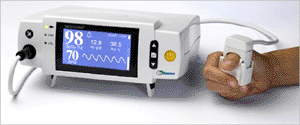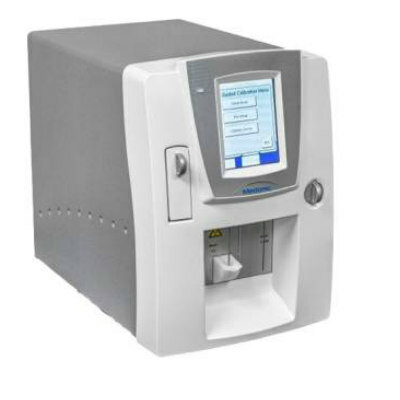Noninvasive Hemoglobin Monitor Uses Occlusion Spectroscopy Technology
By LabMedica International staff writers
Posted on 30 Jun 2011
A noninvasive hemoglobin (Hb) monitor, which measures key blood parameters, reduces the risk of a technician's contact with donor blood. Posted on 30 Jun 2011
The portable noninvasive device operates via a ring-shaped sensor that is fitted on the donor's finger. The device applies pressure, temporarily gently squeezing the finger to over-systolic pressure, similar to blood pressure measurements, thus occluding local blood flow. During the occlusion, optical elements in the sensor, using an array of calibrated light sources, measure absorption, and scattering of the light transmitted through the finger.

Image: OrSense device measures blood parameters (Photo courtesy of OrSense).
Called occlusion spectroscopy, the method provides a quick, accurate, and painless measurement of the donor's blood constituents, while improving the donor's comfort, reducing infection risk, and providing the medical staff with accurate readings and immediate results.
Developed by OrSense Ltd. (Nes Ziona, Israel) the new device will allow donors to undergo blood testing without the need for a finger prick. The noninvasive method will also increase donor and staff safety. The hemoglobin/hematocrit monitor was granted CE approval and was tested on over 8,000 patients and donors at more than 20 sites in the United States and Europe.
OrSense noninvasive Hb monitor performance was highlighted in a study presented during the Euroanesthesia 2011 conference of the European Society of Anesthesia, held in Amsterdam (The Netherlands) from June 11-14, 2011. The study, directed by Prof. P. Singer from the general ICU Rabin Medical Center (Petah Tiqva, Israel) and Aharon Weinstein from OrSense, showed that OrSense's device was able to track accurately rapid changes in Hb levels, and maintained reliability even at very low Hb blood content.
In a statement on World Blood Donors Day, Dr. Emma Castro, CEO of the Transfusion Center of the Spanish Red Cross (Madrid, Spain), said, "A noninvasive system for the measurement of predonation Hb is eagerly awaited by both donors and staff. Our donors are very excited about the implementation of the new OrSense system and we are looking at it as a tool that will contribute to enlarge our blood donor community."
The U.S. Food and Drug Administration (FDA; Silver Spring, MD, USA) gave clearance for the OrSense noninvasive multiparameter monitor for continuous and spot measurement of normal and low signal oximetry for use in hospitals and outpatient sites. The company's CE approved glucose monitor was tested on over 450 diabetic subjects, showing performance similar to those of invasive glucose sensors.
Related Links:
OrSense
European Society of Anesthesia
Rabin Medical Center













